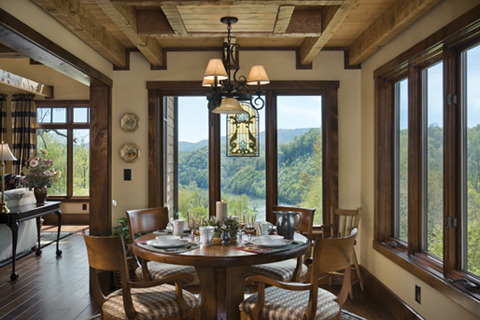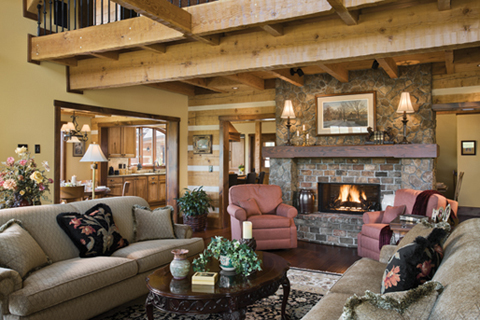Pete Pyles has been in the construction industry for the past 45 years, the last 20 years dedicated to the construction of quality log homes. “I have had a passion for building since my grandfather and father involved me in the art of building construction before I was a teenager,” says Pete. ”I had the good fortune of having quality bred into me while working on some very fine homes as a young person.”
Pete and his wife Jackie have built three homes together for themselves during their 45 years of marriage. The first was built in 1970 with the help of Pete’s father. The second one was their first log home, built in 1990 after three years of research. They also built a log home for their daughter Angie about 10 years ago. This latest home the couple has created for themselves is, in their opinion, the “crowning jewel” of their building accomplishments, incorporating many of the special features they have included in other log homes over the past 20 years. On top of that, it is situated in an exquisite environment. “The Olde River Club is probably the best planned and laid out parcel of mountain property that I have ever seen,” says Pete. There are only 20 lots in the development, approximately two acres each. Every home site has both river and mountain views. The club’s 120 acres of common area provide a sense of space and privacy unique for a gated community. The park-like river access is complete with a large gazebo and stone barbecue grill for the community’s residents to use. Pete and Jackie feel that one of the greatest pluses of their home’s location in the mountains is that there is at least a 10 degree temperature differential, on the cool side, from the flatlands of North Carolina.

The Pyles live in this rural paradise without the typical hassles of property maintenance associated with rural living. The Olde River Club is always manicured; the common grounds are mowed and maintained by the club. The streets are paved and the utilities are underground. Although the property seems completely removed from the hustle-bustle of an urban area, Pete and Jackie have access to four big box stores and several major shopping areas within 45 minutes of their home. Ideal for retirees, the area is also loaded with recreational and cultural opportunities for younger families. Canoeing and fishing expeditions abound on the wild and scenic historic New River.
The lot is perched on a hillside overlooking the New River, a waterway loaded with early American history, and it captures not only one, but two magnificent views of the winding river. “It is something akin to looking down on a rainbow,” says Jackie, “and we get to see it every minute of every day.”
“As is usual with the homes we build,” says Pete, “we completely planned and designed our home from the ground up.” The home was designed for the two of them, but with enough space to accommodate visits from family and friends. “Each room in the house is our favorite,” says Jackie. “Our home is very open and the flow of the floorplan allows each room to complement those adjacent to it. Every window has a very pleasant view which adds to the beauty and comfort of any room we find ourselves in.” Pete and Jackie operate their building business, Country Comfort Homes, from an office in the lower level of the home. The main floor, garage, and breezeway are built on the same floor elevation, making access to the home very easy. The couple also installed an accessible elevator, so going from floor to floor is also easy.

“In all of the log homes we build,” explains Pete, “we use only 6×12 Western hemlock logs for the walls, Douglas fir for heavy timber framing, and spruce for 2×6 tongue-and-groove flooring and the roof deck.” He says that Western hemlock and Douglas fir are both superior woods in terms of dimensional stability. The hemlock has an optimum moisture content, which produces minimal settlement and minimal checking, a real plus for log walls. “We are able to get hemlock in lengths up to 40 feet,” Pete adds, “thus eliminating maintenance-demanding splices in most walls.” Another plus for hemlock is that in all of his years of building log homes, Pete has never seen a carpenter bee hole in a hemlock log. Pete uses Douglas fir for the post-and-beam elements in his homes, describing the wood as straight-grained and superior in strength to most species. “It has a great strength to weight ratio due to its density and hardness,” he says. “The density and grain factors also produce a greater ability to hold nails, which makes a big difference when using close tolerance spruce floor decking. It eliminates squeaking floors.”
Pete and Jackie used a four-inch functional joint chinked with Perma-Chink, a product from Perma-Chink Systems. The chinking provides weather tightness, as the elasticity of the product accommodates the very slight expansion and contraction of the 6×12 logs as they take on and give off moisture during changes in atmospheric conditions. Pete says, “The R-value of the log is about 7 and the chink joint is about 22. This ratio of log to chink joint and the differential in R-value of the two components produces a wall with an average R-value of approximately 11. The roofing material is an asphalt Presidential Shake manufactured by Certainteed and the roof insulation consists of closed-cell insulation laminated to 7/16-inch thick OSB, providing an R-value of about 30.”
Pete was, naturally, his own general contractor and used a proven crew of high-quality subcontractors. Ben Vaughn, the only log home builder Pete uses, erected the log package. Allen Myers, a master carpenter, handled the general carpentry. Pete did most of the “grunt” work, as well as all of the structure’s staining and chinking. Jackie did all of the interior decorating, chose the finish materials, and gave special attention to the trim stain work, including the 23 knotty alder doors that have a fine furniture finish.

Ask Pete and Jackie what, if anything, they would change about their new home and Pete exclaims, “Not a thing! A year of in-depth planning for the right log structure, fixtures, and furnishings has produced what we call our masterpiece.” Ask them what advice they would offer those building a log home of their own and they have much to offer. “First,” says Pete, “find the right property for you. It’s not an easy task, but an important one, as you want to make sure you are happy with your environment.” Also important is finding a log home builder who has a passion for building high-quality homes, as opposed to just “selling another load of wood.” He also recommends going on site to see a home erection in progress. Most important of all, “Get to know the builder,” Pete says emphatically. “Any home is only as good as the experience and integrity of the builder. Research, research, research. The work will pay off in the end.”
The Pyles are extremely happy in their new home and each of them feels a deeply satisfying sense of pride and accomplishment. Jackie sums up their experience: “It is definitely a home that suits and defines both of us. Some very vigorous discussions assured that.” Judging by the couple’s successful track record of building homes together, their smiling faces, and very evident affection for one another, their methods of communication must be stellar, and certainly deserving of their everyday view of a rainbow.
Photos courtesy of www.rogerwadestudio.com

